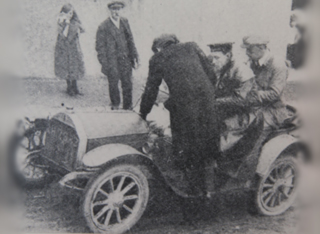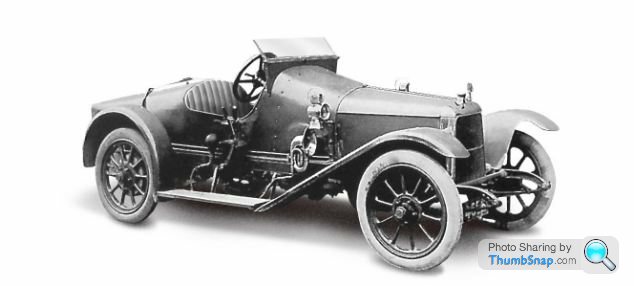A Tribute to Lionel Martin
Discussion
On 25th October, the AMOC are celebrating the first outing of Lionel Martin's Aston Martin engine.
It was Sunday 25th October 1914, when Lionel Martin took the ‘hybrid’ (as the prototype later became known) down to Brighton, accompanied by some other pioneer motorists on an end of season run, organised by the magazine ‘The Light Car and Cyclecar’. After lunch, somebody suggested that an attempt should be made on the Cindertrack Hill (which at that time was occasionally used for official hill climbs).
We thought we would replicate the run, but will have several starting points, (London, Manchester, Cornwall, Eton, Oxford and Cambridge) all linked to times in Lionel Martin's life.
At Cindertrack Hill, we are planning to photograph any Aston with the same background as Lionel was pictured with, precisely 100 years before.
In the evening, there is a dinner in the Royal Banqueting Suite of the Royal Pavilion.
Entry for the Drive, Cindertrack Hill and Dinner in the Royal Pavilion is £125.
To find out more details, see photos of the original occasion and the beauty of the Royal Pavilion, please click here: [url] http://www.amoc.org/content/view/1919/933/ [\url]
Anne
It was Sunday 25th October 1914, when Lionel Martin took the ‘hybrid’ (as the prototype later became known) down to Brighton, accompanied by some other pioneer motorists on an end of season run, organised by the magazine ‘The Light Car and Cyclecar’. After lunch, somebody suggested that an attempt should be made on the Cindertrack Hill (which at that time was occasionally used for official hill climbs).
We thought we would replicate the run, but will have several starting points, (London, Manchester, Cornwall, Eton, Oxford and Cambridge) all linked to times in Lionel Martin's life.
At Cindertrack Hill, we are planning to photograph any Aston with the same background as Lionel was pictured with, precisely 100 years before.
In the evening, there is a dinner in the Royal Banqueting Suite of the Royal Pavilion.
Entry for the Drive, Cindertrack Hill and Dinner in the Royal Pavilion is £125.
To find out more details, see photos of the original occasion and the beauty of the Royal Pavilion, please click here: [url] http://www.amoc.org/content/view/1919/933/ [\url]
Anne
Edited by annereed on Tuesday 29th April 21:44
Thank you for mentioning this event, Anne.
I am interested in the early history, and had not heard about the 1914 drive before. There do tend to be differing versions reported, of many of the early events, so it can become confusing.
I hope that you do not mind me asking one history question?
Your club describes the car named the 'hybrid, with it's 1389cc Aston–Martin engine, which took part in the drive to Brighton on 25th October 1914.

What connection does the 'hybrid' have, with the famous first Bamford & Martin car, 'Coal Scuttle'? That first Aston-Martin model is described as having been built in 1914, registered AM 4656 on 16th March 1915, and fitted with a 1389cc 4 cylinder side valve Coventry Simplex engine.

Dewi
Response from David Wright:
The 1914 drive has been mentioned in several books and journals ............ but a full report appeared in October 1914 in The Light Car and Cyclecar after the drive down to Brighton, along with the pictures. It wasn’t actually the first time that the engine was taken out, it was the first time and only known time that the Hybrid was photographed before it simply disappeared, so in effect the first known photograph of an Aston......... albeit the prototype........ but along with Lionel himself in the driving seat.
The Hybrid was the name by which the prototype A-M later became known by. Lionel constructed it in 1914 using an older (2nd hand!!) Isotta Fraschini chassis, and a brand new bespoke 1389cc engine that he had got Coventry-Simplex to build especially for him. He took the Hybrid out on quite a few occasions, testing the A-M engine and other mechanical components, whilst the first (to be road registered) A-M was being constructed. It was that very same engine that was then transferred in 1915 to Coal Scuttle, along with possibly some other mechanical components, but definitely not the chassis or body.
I would suggest that the build date for Coal Scuttle should probably read 1914-1915, as I don’t believe it was completed until it was road registered on the 16th March 1915.
Anne
Response from David Wright:
The 1914 drive has been mentioned in several books and journals ............ but a full report appeared in October 1914 in The Light Car and Cyclecar after the drive down to Brighton, along with the pictures. It wasn’t actually the first time that the engine was taken out, it was the first time and only known time that the Hybrid was photographed before it simply disappeared, so in effect the first known photograph of an Aston......... albeit the prototype........ but along with Lionel himself in the driving seat.
The Hybrid was the name by which the prototype A-M later became known by. Lionel constructed it in 1914 using an older (2nd hand!!) Isotta Fraschini chassis, and a brand new bespoke 1389cc engine that he had got Coventry-Simplex to build especially for him. He took the Hybrid out on quite a few occasions, testing the A-M engine and other mechanical components, whilst the first (to be road registered) A-M was being constructed. It was that very same engine that was then transferred in 1915 to Coal Scuttle, along with possibly some other mechanical components, but definitely not the chassis or body.
I would suggest that the build date for Coal Scuttle should probably read 1914-1915, as I don’t believe it was completed until it was road registered on the 16th March 1915.
Anne
Thank you very much Anne and David, for the information about 'Hybrid'.
I have become interested in the Bamford and Martin period, and have tried to compile a list of the cars built from 1913 to 1925. My information source has been the internet, but I did spot some of the more obvious errors.
As it is thought that only about 61 cars were produced during that period, hopefully my pursuit is not too much like train spotting.
Having now listed the details, and some history of 21 cars, I seem to have gathered everything that is available from the internet.
I was surprised to find so little information about the car called 'Bunny'. Considering that it set records and competed at several motor sport venues, even the chassis number seems impossible to find. The other mystery is the second prototype (presumably A2), said to have been built in 1920. Apart from references to it being built, nothing else seems to be mentioned.
I wonder if David, or any other AMOC members who have an interest in this subject, would like to see my list, and perhaps point out the inevitable mistakes?
Thank you.
Edited by Dewi 1 on Tuesday 6th May 18:16
V8LM said:
AMOC, and moreover the Heritage Trust, will be very interested in your work. Might be easiest to make contact with the Registrar via the AMOC forum and post in the PreWar section.
Link here http://www.amoc.org/forum/index.php also should add that the Pre-War section of the forum is open to guests. You will have to register but do not have to be a member of the AMOC to post within. Thank you V8LM and RichB.
I will follow your suggestions.
I clicked your link Richard, to have look at the Pre-war section. Found a topic about chassis 1913, in which you made a comment. Quite possibly I am wrong, but I think those references to the photographs might be the wrong way round. My understanding (although only from internet research) is that the car at Shelsley is not the the sister car, but is chassis 1913, raced as number 15 in the 1922 French GP, later called Green Pea and amazingly still used in motorsport competitions now.
Fascinating, and how brave the racers were in those days. I was amazed to discover that the 1922 French GP lasted 6 hours for the winner, and further hour for the second place car.
Hello
Work is underway on the Pre-War section of the Aston Martin Register, which aims to have information on all Aston Martins. The Registrar, Tim Cottingham, (registrar@amht.org.uk) may well be interested in the information you have.
If you are near Donington Circuit on 7th June, you are welcome to come and see many of these Pre-War cars racing in the St John Horsfall race. Some will also be competing at our Oulton Park meeting this Saturday (10th May) but the Horsfall race is the one we get most attending.
It is a great opportunity to get close to the cars and talk to the drivers, who themselves know a lot of the history around these cars.
Anne
Work is underway on the Pre-War section of the Aston Martin Register, which aims to have information on all Aston Martins. The Registrar, Tim Cottingham, (registrar@amht.org.uk) may well be interested in the information you have.
If you are near Donington Circuit on 7th June, you are welcome to come and see many of these Pre-War cars racing in the St John Horsfall race. Some will also be competing at our Oulton Park meeting this Saturday (10th May) but the Horsfall race is the one we get most attending.
It is a great opportunity to get close to the cars and talk to the drivers, who themselves know a lot of the history around these cars.
Anne
Lionel Martin, although from what might be called "the upper classes" was no great respecter of authority. Just before setting up the car company, he had been banned from driving for what seems to have been over a year, which was an incentive to get his tricycle out and break his third RRA record.
In the early days of the company (after the Great War) it sometimes seems like he had some engines, some chassis, a body or two but just the one set of number plates. So cars could appear in various combinations. Bunny was licenced in June 1921, allegedly with a repaired older chassis and a pre-war engine, presumably one of the first batch from Coventry Simplex. It's complicated......
In the early days of the company (after the Great War) it sometimes seems like he had some engines, some chassis, a body or two but just the one set of number plates. So cars could appear in various combinations. Bunny was licenced in June 1921, allegedly with a repaired older chassis and a pre-war engine, presumably one of the first batch from Coventry Simplex. It's complicated......
Gassing Station | Aston Martin | Top of Page | What's New | My Stuff




